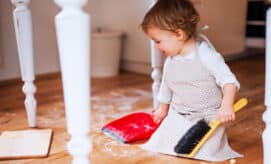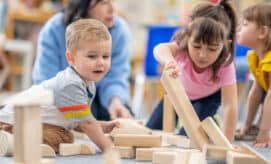With many of us still sheltering in place, it’s a perfect opportunity to take some time to clean and organize your environment. This time of social isolation can make us much more aware of what does and doesn’t work well in our work and living spaces.
Because there is so much that we can’t control right now, achieving small goals, like discarding items that are no longer needed or making a space more user-friendly, can feel especially therapeutic. In this article, we share a few simple tips to help you tidy and organize your space.
General Clean-Up Tips
These tips can be used in your home, your kitchen, your classroom or anywhere else that could use some sprucing up!
-
Make a list of the top 3 projects you’d like to get done. Have you been noticing that your fridge needs a deep clean? Or have you been wanting to empty out and organize one of your cabinets? Whatever projects have been calling your name, make a list of the top 3 that you’d really like to accomplish and work through them one by one. Make sure you complete one task before moving on to the next to prevent more clutter.
-
Less is more. Whether you are cleaning out a closet, a cabinet, or even a drawer, really consider each item that you have been holding onto. Is it in good condition? Does it add value to your space? Is it something that you use often? Try to get rid of items that are damaged, are not being used, or do not “spark joy.” In general, cleaning out items that do not get used means less clutter and more opportunity to enjoy the items that you value. In classrooms, having too many items can actually be overwhelming for children. Being able to choose among fewer, but more open-ended play options allows for deeper, richer, and more engaging play.
Classroom Organization
In the busyness of the day, teachers are moving quickly and do not always have time to keep things as organized or tidy as we’d like. These quick tips can help you to easily refresh and revamp your classroom.
Quick Refresh
-
Start with cluttered and messy spaces. In most classrooms, there is an area or two that seems to always get messy. Maybe it is your dress-up center or your blocks. Wherever it might be, start there and consider how many items are in the space. It might be that this area is easily cluttered because there are simply too many items. Consider removing a few materials so that the space is less likely to become cluttered.
-
Find items that are worn, or damaged. Do you have flyers or notices hanging in your classroom that have been torn? Are there documentations or displays that are outdated? Removing these items and replacing them with new materials can quickly and easily make your classroom feel refreshed. Even if you do not have replacements readily available, it can be beneficial to remove old items. The blank space will serve as a reminder to add something new when you have the time.
-
Try a classroom swap. Budgets are often tight in early learning programs, and so it is not always feasible to buy new materials. Rather than purchasing, consider swapping a few materials with other classrooms. This way, children will have fresh items to engage with. You might even consider scheduling a monthly swap so educators can bring materials into a shared space (such as the break room) for sharing and swapping with other teachers.
Bigger Projects
-
Repair and replace broken items. Most early learning programs or classrooms have several books that are damaged, toys or materials that are broken, and other items that need to be repaired or replaced. Start by making a list of these items or gathering and placing them in one container. Consider whether they are still usable or if they are broken beyond repair. Some broken items can be unsafe for children to use, and so it is important to carefully consider whether or not items should be saved. When time becomes available, make your way down the list of repairs and replacements. It can help to organize them by priority so that you do not feel overwhelmed by the time and money you would need to allocate if you purchased everything at once.
-
Make learning boxes. Learning boxes are large or small tupperware boxes that contain ready-to-go activities for children. They can contain playdough and accessories, paper and crayons, a variety of loose parts for building, or any other items that children in your classroom enjoy. These easy-to-grab boxes can be great timesaving tools, especially for teachers who open or close the classroom, because they are easy to set up and clean up. Click here for some more ideas to create open-ended, budget-friendly learning boxes.
-
Get the deep cleaning done as a team. Are there things that need to be deep cleaned in your room? Fridges, shelves, and cubbies can collect a lot of dust and dirt while not being cleaned as often as other surfaces in the classroom. These deep cleaning projects can be time consuming and labor intensive. To share the load, work together with your classroom team to come up with a list of things that need to be cleaned and then allow everyone to sign up for one or two jobs. This will ensure that the responsibilities are fairly balanced. Then, decide when and how these projects will get done by making up a quick schedule.





